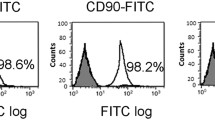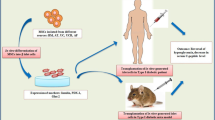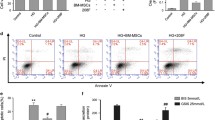Abstract
Cardiovascular manifestations are one of the major complications of type 1 diabetes mellitus (T1DM) and supersede the slow progression of DM in most cases as the leading cause of mortality. There have been many studies and trials in regenerating the functional β-cells of islets from mesenchymal stem cells (MSCs) with varied success. The effect of MSCs ex vivo differentiated to mimic functional insulin-secreting β-cells of islets and their impact on restoration of diabetic complications and transplantation via systemic delivery have not been well studied. In the current study, bone marrow MSCs differentiated to insulin-secreting β-cells are used to treat STZ-induced diabetic rats. The post-homing effects of the differentiated MSCs (dMSCs) were endogenous with definite reversal of diabetic parameters. Consequently, the altered cardiac functions like heart beat rate, left ventricular performance, contractility index and physiological body weight gain due to hyperglycemia were amelorated into normacy. The primary onset cardiac perfomance and the endothelial activation were well evidenced by high fibrinogen levels and systolic blood pressure (SBP) being reversed on the treatment by dMSCs. Further high basal [Ca2+]c in isolated endothelial cells and thereby increased ROS confirmed the endothelial activation. The levels of pro-apoptotic makers p53 and Bax were highly expressed in the diabetic groups indicating oxidative stress through ROS induced by high cytosolic calcium skewing the cells towards apoptosis. The expression of the anti-apoptotic marker Bcl-2 was observed to be low in the diabetic group further augmenting the stress state of endothelial cells (ECs) in T1DM. Restoration of [Ca2+]c chelates ROS and the subsequent reversal of pro- and anti-apoptotic markers after the successful treatment of dMSCs proved that endogenous reconstitution of insulin secretion improves diabetic-induced cardiac manifestations.



Similar content being viewed by others
References
Abdel Aziz MT, El-Asmar MF et al (2008) Effect of bone marrow-derived mesenchymal stem cells on cardiovascular complications in diabetic rats. Med Sci Monit 14(11):BR249–BR255
Abdel Aziz MT, El-Asmar MF et al (2013) The effect of a novel curcumin derivative on pancreatic islet regeneration in experimental type-1 diabetes in rats (long term study). Diabetol Metab Syndr 5(1):75
Bandyopadhyay G, Sajan MP et al (2001) Glucose activates protein kinase C-zeta /lambda through proline-rich tyrosine kinase-2, extracellular signal-regulated kinase, and phospholipase D: a novel mechanism for activating glucose transporter translocation. J Biol Chem 276(38):35537–35545
Banerjee M, Kumar A, Bhonde RR (2005) Reversal of experimental diabetes by multiple bone marow transplantation. Biochem Biophys Res Commun 328(1):318–325
Bauer S, Nauck MA (2014) “Polypharmacy in people with Type 1 and Type 2 diabetes is justified by current guidelines-a comprehensive assessment of drug prescriptions in patients needing inpatient treatment for diabetes-associated problems.” Diabet Med (in press)
Bernatova I (2014) Endothelial dysfunction in experimental models of arterial hypertension: cause or consequence? BioMed Res Int 2014:598271
Calafiore R, Montanucci P et al (2014) Stem cells for pancreatic beta-cell replacement in diabetes mellitus: actual perspectives. Curr Opin Organ Transplant 19(2):162–168
Castro CN, Barcala Tabarrozzi AE et al (2014) Curcumin ameliorates autoimmune diabetes. Evidences in accelerated murine models of type 1 diabetes. Clin Exp Immunol (in press)
Ezquer F, Ezquer M et al (2009) Endovenous administration of bone-marrow-derived multipotent mesenchymal stromal cells prevents renal failure in diabetic mice. Biol Blood Marrow Transplant 15(11):1354–1365
Fiorentino TV, Prioletta A et al (2013) Hyperglycemia-induced oxidative stress and its role in diabetes mellitus related cardiovascular diseases. Curr Pharm Des 19(32):5695–5703
Gabr MM, Zakaria MM et al (2013) Insulin-producing cells from adult human bone marrow mesenchymal stem cells control streptozotocin-induced diabetes in nude mice. Cell Transplant 22(1):133–145
Giacco F, Brownlee M (2010) Oxidative stress and diabetic complications. Circ Res 107(9):1058–1070
Goldweit RS, Borer JS et al (1985) Relation of hemoglobin A1 and blood glucose to cardiac function in diabetes mellitus. Am J Cardiol 56(10):642–646
Haidara MA, Khloussy H et al (2004) Impact of alpha-tocopherol and vitamin C on endothelial markers in rats with streptozotocin-induced diabetes. Med Sci Monit 10(2):BR41–BR46
Haidara MA, Yassin HZ et al (2006) Role of oxidative stress in development of cardiovascular complications in diabetes mellitus. Curr Vasc Pharmacol 4(3):215–227
Hartge MM, Kintscher U et al (2006) Endothelial dysfunction and its role in diabetic vascular disease. Endocrinol Metab Clin N Am 35(3):551–560, viii–ix
Heck PM, Hoole SP et al (2010) Hyperinsulinemia improves ischemic LV function in insulin resistant subjects. Cardiovasc Diabetol 9:27
Holditch SJ, Terzic A et al (2014) Concise review: pluripotent stem cell-based regenerative applications for failing beta-Cell function. Stem Cells Transl Med 3(5):653–661
Irrinki KM, Mallilankaraman K et al (2011) Requirement of FADD, NEMO, and BAX/BAK for aberrant mitochondrial function in tumor necrosis factor alpha-induced necrosis. Mol Cell Biol 31(18):3745–3758
Jurewicz M, Yang S et al (2010) Congenic mesenchymal stem cell therapy reverses hyperglycemia in experimental type 1 diabetes. Diabetes 59(12):3139–3147
Karaoz E, Genc ZS et al (2010) Protection of rat pancreatic islet function and viability by coculture with rat bone marrow-derived mesenchymal stem cells. Cell Death Dis 1:e36
Karavanaki K, Kazianis G et al (2008) Early signs of left ventricular dysfunction in adolescents with type 1 diabetes mellitus: the importance of impaired circadian modulation of blood pressure and heart rate. J Endocrinol Investig 31(4):289–296
Kavak S (2013) Effects of insulin on altered mechanical and electrical papillary muscle activities of diabetic rats. J Membr Biol 246(1):31–37
Kim SJ, Ju A et al (2013) Chronic alcohol consumption, type 2 diabetes mellitus, insulin-like growth factor-I (IGF-I), and growth hormone (GH) in ethanol-treated diabetic rats. Life Sci 93(21):778–782
Lipsett M, Finegood DT (2002) beta-cell neogenesis during prolonged hyperglycemia in rats. Diabetes 51(6):1834–1841
Mallilankaraman K, Gandhirajan RK et al (2011) Visualization of vascular Ca2+ signaling triggered by paracrine derived ROS. J Visualized Exp 58
Mallilankaraman K, Doonan P et al (2012) MICU1 is an essential gatekeeper for MCU-mediated mitochondrial Ca(2+) uptake that regulates cell survival. Cell 151(3):630–644
Maricic L, Vceva A et al (2013) Assessment of endothelial dysfunction by measuring von Willebrand factor and exhaled nitric oxide in patients with chronic obstructive pulmonary disease. Coll Anthropol 37(4):1153–1160
Migliorini A, Bader E et al (2014) Islet cell plasticity and regeneration. Mol Metab 3(3):268–274
Miller BA, Hoffman NE et al (2014) TRPM2 channels protect against cardiac ischemia-reperfusion injury: role of mitochondria. J Biol Chem 289(11):7615–7629
Moraes R, Valente RH et al (2014) Alterations of the kidney cortex proteome in response to exercise training in normoglycemic and hyperglycemic conditions. Curr Top Med Chem 14(3):450–461
Nathan DM, Cleary PA et al (2005) Intensive diabetes treatment and cardiovascular disease in patients with type 1 diabetes. N Engl J Med 353(25):2643–2653
Newsholme P, Rebelato E et al (2012) Reactive oxygen and nitrogen species generation, antioxidant defenses, and beta-cell function: a critical role for amino acids. J Endocrinol 214(1):11–20
Ouyang J, Huang W et al (2014) Generation of insulin-producing cells from rat mesenchymal stem cells using an aminopyrrole derivative XW4.4. Chem Biol Interact 208:1–7
Padiya R, Chowdhury D et al (2014) Garlic attenuates cardiac oxidative stress via activation of PI3K/AKT/Nrf2-Keap1 pathway in fructose-fed diabetic rat. PLoS ONE 9(5):e94228
Scognamiglio R, Avogaro A et al (1998) Myocardial dysfunction and adrenergic cardiac innervation in patients with insulin-dependent diabetes mellitus. J Am Coll Cardiol 31(2):404–412
Shapiro AM, Lakey JR et al (2000) Islet transplantation in seven patients with type 1 diabetes mellitus using a glucocorticoid-free immunosuppressive regimen. N Engl J Med 343(4):230–238
Soleimani M, Nadri S (2009) A protocol for isolation and culture of mesenchymal stem cells from mouse bone marrow. Nat Protoc 4(1):102–106
Szot GL, Koudria P et al (2007) Transplantation of pancreatic islets into the kidney capsule of diabetic mice. J Visualized Exp 9:404
Tada H, Oida K et al (1992) Effects of probucol on impaired cardiac performance and lipid metabolism in streptozotocin-induced diabetic rats. J Cardiovasc Pharmacol 20(2):179–186
Tang DQ, Cao LZ et al (2004) In vivo and in vitro characterization of insulin-producing cells obtained from murine bone marrow. Diabetes 53(7):1721–1732
Veriter S, Gianello P et al (2013) Bioengineered sites for islet cell transplantation. Curr Diabetes Rep 13(5):745–755
Wang D, Wang C et al (2014) Endothelial dysfunction and enhanced contractility in microvessels from ovariectomized rats: roles of oxidative stress and perivascular adipose tissue. Hypertension 63(5):1063–1069
Weir GC, Laybutt DR et al (2001) Beta-cell adaptation and decompensation during the progression of diabetes. Diabetes 50(Suppl 1):S154–S159
Wu XH, Liu CP et al (2007) Reversal of hyperglycemia in diabetic rats by portal vein transplantation of islet-like cellsgenerated from bone marrow mesenchymal stem cells. World J Gastenterol 13(24):3342–3349
Yang SJ, Je Lee W et al (2014) Effects of N-adamantyl-4-methylthiazol-2-amine on hyperglycemia, hyperlipidemia and oxidative stress in streptozotocin-induced diabetic rats. Eur J Pharmacol
Zhang Y, Bone RN et al (2012) Regeneration of pancreatic non-beta endocrine cells in adult mice following a single diabetes-inducing dose of streptozotocin. PLoS ONE 7(5):e36675
Zoccali C (2006) Endothelial dysfunction and the kidney: emerging risk factors for renal insufficiency and cardiovascular outcomes in essential hypertension. J Am Soc Nephrol 17(4 Suppl 2):S61–S63
Acknowledgments
We thank Muniswamy Madesh, Center for Translational Medicine, Temple University, Philadelphia, USA for confocal micorscopy help. We extend our gratitude to Refaat El-Najar, electron microscopy unit, KKU and Mahmoud Ahmad AL- Khateeb, Department of Physiology, KKU, for help in histology work. This work was supported by internal funds from the Center for Stem Cell Research and the Department of Physiology, King Khalid University.
Author contributions
M.H., M.A.Y. and H.C.C. designed the project. M.H., A.A., M.A.Y., M.M., E.A.M.S and H.C.C. performed the experimental work and analyzed the results. M.H., M.A.Y., M.M. A.A.H and H.C.C. contributed reagents. H.C.C., M.H. and A.A. wrote the manuscript. Experimental work was carried out in the Department of Physiology, Faculty of Medicine, Cairo University, Cairo, Egypt and the Center for Stem Cell Research, College of Medicine, King Khalid University, Abha SA. All authors discussed the results and commented on the manuscript.
Author information
Authors and Affiliations
Corresponding author
Rights and permissions
About this article
Cite this article
Haidara, M.A., Assiri, A.S., Youssef, M.A. et al. Differentiated mesenchymal stem cells ameliorate cardiovascular complications in diabetic rats. Cell Tissue Res 359, 565–575 (2015). https://doi.org/10.1007/s00441-014-2034-2
Received:
Accepted:
Published:
Issue Date:
DOI: https://doi.org/10.1007/s00441-014-2034-2




